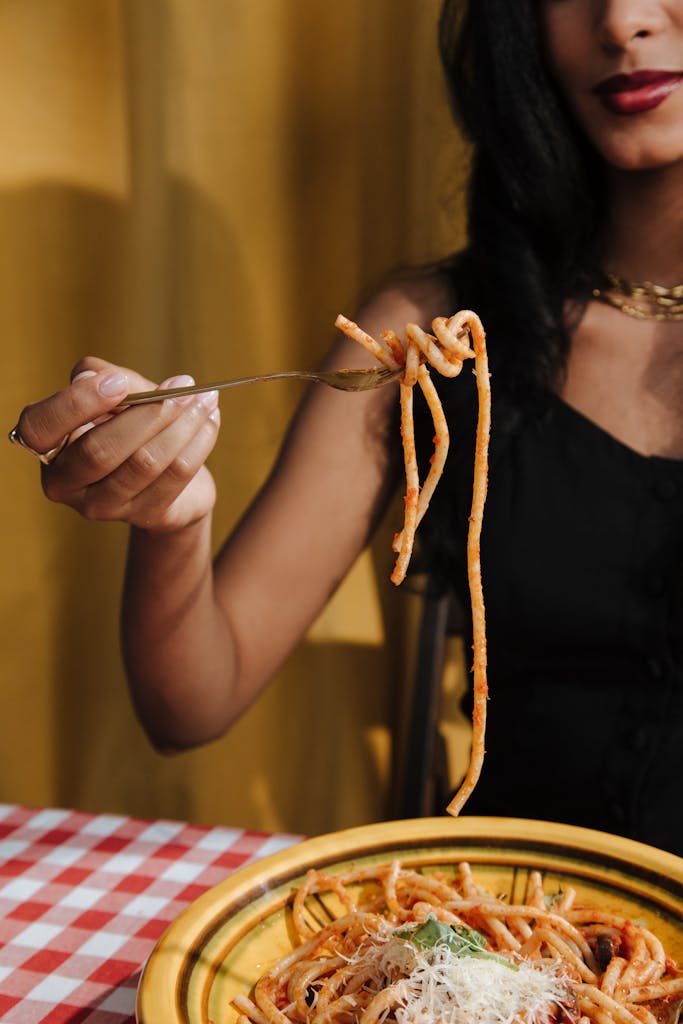
You’ve likely wolfed down countless meals while scrolling your phone, barely tasting that expensive takeout you ordered. I used to complete entire dinners without recalling a single bite – talk about wasting good food and money. Here’s the thing: mindful eating isn’t just some wellness trend that’ll disappear next month. It’s actually a game-changer that can transform how you experience food, improve your digestion, and help you finally understand what your body actually needs. But where do you even start?
Key Takeaways
- Eliminate distractions by turning off screens and creating a designated, clutter-free eating space for focused meals.
- Slow your eating pace by chewing each bite 20-30 times and setting utensils down between bites.
- Distinguish between physical hunger cues like stomach growling and emotional triggers like stress or habit.
- Engage all five senses by noticing food colors, aromas, textures, temperatures, and sounds while eating.
- Practice gratitude before meals by taking a moment to appreciate the nourishment you’re about to receive.
Eat Without Distractions
Setting aside your phone and turning off the TV might feel like torture at first, but eating without distractions is a game-changer for mindful eating. I learned this the hard way after realizing I’d demolished an entire pizza while binge-watching Netflix, with zero memory of actually tasting it.
Create a designated eating zone that’s completely distraction-free. Clear away clutter, silence your devices, and focus solely on your meal. This isn’t about depriving yourself of entertainment – it’s about reclaiming control over your eating habits.
Encourage your family to ditch screens during mealtimes too. Replace scrolling with actual conversation, and you’ll discover something amazing: you’ll actually taste your food, recognize when you’re full, and transform eating from mindless consumption into intentional nourishment.
Just like creating a morning sanctuary that feels nurturing and calm, your distraction-free eating space becomes a gift to yourself that promotes mindfulness and presence.
Slow Down Your Eating Pace

You’re probably wolfing down your meals like you’re in some kind of speed-eating contest, but slowing down can actually make your food taste better and help you feel more satisfied.
Try chewing each bite about 20-30 times instead of your usual three quick chomps, and set your fork down between bites to give yourself natural breaks. I know it sounds tedious at first, but these simple tricks force you to actually taste your food and give your brain time to register when you’re getting full.
Just like building any new routine, consistent daily habits around mindful eating take time to develop, so be patient with yourself as you practice this slower approach to meals.
Chew Each Bite Thoroughly
When I first heard that chewing each bite 20-30 times could help me eat less, I’ll admit I rolled my eyes a bit. But here’s the thing – when you chew thoroughly, you’re actually giving your brain time to catch up with your stomach. It takes about 20 minutes for fullness signals to kick in, and mindful chewing buys you that essential time.
I started counting my chews during lunch breaks, and honestly, it felt ridiculous at first. But after two weeks, I noticed I was satisfied with smaller portions. When you chew each bite properly, you taste more flavors and textures, which makes meals more satisfying. Plus, your digestion improves dramatically. This simple habit helps you slow down eating while gaining real control over your portions.
Set Fork Down Between
The simple act of putting your fork down between bites might sound almost too basic to matter, but I discovered it’s one of the most powerful tools for slowing down my eating pace. This technique forces you to pause, creating space between each bite that transforms your entire relationship with food.
When you set your utensils down deliberately, you’re giving your body those essential 20 minutes it needs to register fullness signals. I used to inhale my dinner in 5 minutes flat, then wonder why I felt uncomfortably stuffed. Now, eating mindfully through this simple pause helps me recognize hunger and fullness cues I’d been bulldozing through for years.
Your eating habits will shift when you eat more slowly and actually taste your food.
Listen to Your Body’s Hunger Signals

Your stomach’s trying to tell you something important, but are you actually listening? Most of us have become experts at ignoring our body’s natural hunger signals, eating when we’re bored, stressed, or simply because it’s “lunchtime” on the clock.
Learning to recognize true physical hunger—like that gentle growling, low energy feeling, or slight lightheadedness—versus emotional eating triggers can transform how you approach food entirely. Just like tracking your energy levels throughout the day can help you better manage your resources and make adjustments, tuning into your body’s hunger cues allows you to eat more intentionally and nourish yourself when you truly need it.
Recognize Physical Hunger Cues
Often, we grab food without asking ourselves a simple question: am I actually hungry? Learning to recognize physical hunger cues puts you back in control of your eating habits. True physical hunger shows up through specific bodily sensations that you can’t ignore.
| Physical Hunger Signs | Emotional Eating Signs |
|---|---|
| Empty, growling stomach | Sudden food cravings |
| Low energy, fatigue | Stress or boredom eating |
| Lightheadedness, weakness | Eating out of habit |
Your body’s pretty smart about signaling genuine physiological hunger. That rumbling belly isn’t just noise—it’s your internal alarm system. When you feel weak or your energy crashes, that’s your cue for nourishment. Check in with yourself before eating and ask: “What’s my body actually telling me right now?”
Distinguish Emotional Vs Physical
Before you reach for that bag of chips, pause and become a detective investigating your own hunger signals. Your body sends clear messages when it truly needs food – stomach growling, energy dipping, or that hollow feeling that says “feed me now.”
But emotional eating sneaks in with different clues: stress from work deadlines, boredom during Netflix binges, or that automatic reach for comfort food after arguments.
Here’s your power move: ask yourself, “Am I eating because my body needs fuel, or because my emotions need soothing?” Physical hunger builds gradually and accepts various foods. Emotional hunger strikes suddenly and demands specific comfort foods like ice cream or pizza.
Master this distinction, and you’ll control your eating choices rather than letting them control you. That’s true mindful eating mastery.
Engage All Five Senses While Eating
When you truly engage all five senses during meals, eating transforms from mindless fuel consumption into a rich, immersive experience that naturally slows you down and increases satisfaction.
Start by paying attention to visual appeal—notice colors, textures, and steam rising from your plate. Inhale deeply before taking that first bite, letting aromas build anticipation. Listen to the satisfying crunch of fresh vegetables or the sizzle of hot food. Feel temperatures and textures as you chew slowly, savoring each bite.
This isn’t some hippie nonsense—it’s strategic eating that helps you enjoy the food more while eating less. When you’re fully present during meals, you’ll naturally recognize when you’re satisfied. Practice mindful eating by putting down your fork between bites, eliminating distractions like phones, and actually tasting what you’re consuming.
Just like creating the perfect home spa environment with dim lighting and natural sounds, mindful eating becomes a form of essential self-care that helps you reconnect with your body’s natural signals and reduces daily stress.
Chew Each Bite Thoroughly
You’ve most likely inhaled your lunch in five minutes flat, barely tasting that sandwich while scrolling through your phone.
When you chew each bite around 20-30 times, you’re not just giving your jaw a workout, you’re actually slowing down your eating pace so your brain can catch up and register when you’re full. This simple habit transforms your entire eating experience, helping you recognize flavors you’ve been missing and giving your digestive system the head start it needs to break down food properly. Nourishing your body with nutritious foods is an act of self-care that makes you feel good both physically and mentally.
Slow Down Eating Pace
Since most of us treat meals like we’re in some kind of speed-eating competition, slowing down your eating pace might feel awkward at first, but it’s one of the simplest ways to transform your relationship with food.
Put that fork down between bites. Seriously, it’s like hitting the pause button on your eating autopilot. When you chew each bite thoroughly, you’re giving your brain the 20 minutes it needs to catch up with your stomach. I used to inhale my lunch in five minutes flat, then wonder why I felt stuffed and sluggish. Now I eat mindfully by taking smaller bites and actually tasting my food. This simple shift helps you slow down eating pace naturally.
Enhance Flavor Recognition
Most people chew their food about 10-15 times before swallowing, but here’s the thing—you’re missing out on a flavor explosion by rushing through your bites. When you commit to chewing each bite 20-30 times, you’re basically becoming a food detective, uncovering layers of taste you never knew existed. That strawberry suddenly reveals hints of sweetness, tartness, and floral notes you’d completely missed before.
This mindful eating approach transforms your relationship with food entirely. Slowing down your chewing activates taste buds that have been sitting on the sidelines, waiting for their moment to shine. You’ll discover that simple foods pack incredible complexity when you give them proper attention. Plus, thorough chewing breaks down food particles more effectively, making digestion smoother and helping you recognize when you’re actually satisfied.
Improve Digestive Health
Your stomach isn’t just a garbage disposal that magically transforms food into energy—it’s actually doing some pretty complex chemistry down there, and you can either help or hinder the process. When you chew each bite for 20-30 seconds, you’re giving your body a serious advantage in digestion. Your saliva contains powerful enzymes that start breaking down food immediately, but only if you give them enough time to work.
Mindful eating through thorough chewing helps you absorb more nutrients while reducing that uncomfortable bloating and gas that makes you feel like a balloon. Your body also detects fullness signals better when you slow down, preventing overeating. Think of chewing as pre-processing your food—the more work you do upfront, the smoother everything runs downstream.
Put Your Utensils Down Between Bites
One simple trick that completely changed my relationship with food was putting my fork down between every single bite, and I’ll be honest – it felt ridiculously awkward at first. But this mindful eating practice forces you to slow down and actually taste your food instead of mindlessly shoveling it in.
When you set your utensils on the table, you’re giving your brain those indispensable 20 minutes it needs to register fullness. This mindfulness technique transforms your eating behaviors from rushed to intentional. You’ll chew thoroughly, savor flavors, and naturally eat smaller portions because continuing becomes more effort than it’s worth.
It’s healthy eating made simple – no complicated rules, just putting down your damn fork. Just like developing a consistent morning routine helps reduce stress and improve focus throughout the day, creating intentional eating habits builds a foundation for better overall wellness.
Create a Designated Eating Space

Where you eat matters just as much as how you eat, and I learned this the hard way after spending months scarfing down cereal while binge-watching Netflix on my couch. Creating a proper eating space transformed my mindful eating practice completely. I designated my kitchen table as my official eating zone, ditching the living room and bedroom snacking forever.
Your eating behaviors improve dramatically when you eliminate distractions like phones and TV. Set up plates, utensils, and proper lighting to create a calm environment. This isn’t about fancy decor—I just added a simple plant and turned off overhead fluorescents.
When you eat in a dedicated space, you’ll notice physical cues like fullness signals that you’ve been missing while distracted. Your brain finally connects with your stomach properly. Just like creating a cozy workspace, incorporating natural elements like plants can make your eating area feel more inviting and help you stay present during meals.
Practice Gratitude Before Meals
Now that you’ve got your eating space sorted out, it’s time to slow down even more before you actually start eating. Practicing gratitude before meals transforms your relationship with food from mindless consumption to intentional nourishment. This simple shift helps you make healthier food choices and appreciate what’s on your plate.
- Take 30 seconds to acknowledge the journey – Think about how your food traveled from seed to plate, including the farmers, drivers, and store workers who made it possible.
- Offer a brief moment of appreciation – Whether it’s a prayer, mantra, or silent thank-you, this helps you move into mindful eating mode.
- Verbalize your gratitude – Simply say “thank you” for the nourishment you’re about to receive.
Consider writing down your meal-related gratitude in a gratitude journal to strengthen this practice and build a lasting habit of appreciation around food.
Recognize Emotional vs. Physical Hunger

After you’ve expressed gratitude for your meal, it’s essential to check in with your body and emotions before taking that first bite. Physical hunger shows up with a growling stomach, low energy, and you’ll happily eat an apple.
Emotional hunger? That’s when you’re craving those comfort foods like pizza or ice cream after a stressful day. I’ve learned this the hard way after countless late-night cookie raids that left me feeling worse, not better. Mindful eating means recognizing these signals and addressing the real emotion driving your craving, rather than eating your feelings away. This awareness is particularly important because your gut-brain connection plays a crucial role in emotional responses and can influence your decision-making around food choices.
Stop Eating When You Feel Satisfied
Once you’ve figured out whether you’re truly hungry or just stress-eating your way through Tuesday, the next challenge becomes knowing when to put down the fork. Your body’s constantly sending signals about fullness, but most of us ignore them like spam emails. Learning to recognize satisfaction versus stuffed-to-the-gills takes practice, but it’s worth mastering.
Your body sends fullness signals constantly, but you’re treating them like junk mail while bulldozing through another helping.
Here’s how to stop eating when satisfied:
- Rate your hunger on a scale of 1-10 before you eat, aiming to stop around 6 or 7
- Put your fork down between bites and check in with your stomach every few minutes
- Save leftovers for your next meal instead of forcing down that last amount of food
You don’t need to clean your plate—your childhood wasn’t that traumatic. Try starting each meal with one mindful bite to set the tone for more conscious eating throughout the entire dining experience.
Choose Smaller Plates and Portions
While your brain might insist you need that mountain of spaghetti to feel satisfied, your eyes are actually playing tricks on you—and smaller plates can help you outsmart them. Switching from a 12-inch plate to a 9-inch one can slash your calorie intake by up to 22%, and trust me, you won’t miss those extra calories. Your mind and body will thank you for this simple swap that makes healthy foods look more generous and satisfying.
This mindful eating helps rewire your eating behaviors without feeling deprived. When you serve yourself on smaller dishes, your brain sees a full plate and feels satisfied, even with less food. It’s like having a personal portion-control assistant that doesn’t judge your third helping of dessert—because there won’t be one.
Focus on Food Quality Over Quantity

Now that you’ve mastered the art of plate downsizing, let’s talk about what actually goes on those smaller plates—because filling a 9-inch dish with processed junk is like putting premium gas in a broken-down car.
Quality-focused mindful eating practices transform your relationship with food from mindless consumption to intentional nourishment. When you prioritize nutrient-dense ingredients over empty calories, you’ll discover satisfaction comes from richness, not volume.
True satisfaction emerges when you trade mindless consumption for intentional nourishment, choosing richness over mere volume.
- Choose vibrant, whole foods that offer sustained energy instead of processed options that leave you crashing within an hour
- Savor complex flavors and textures rather than rushing through bland, convenience meals
- Appreciate the artistry in preparation by selecting fresh ingredients that engage all your senses
This approach prevents mindless eating while building a powerful, intentional relationship with food.
Take Deep Breaths Before Eating
Before you grab that fork and start shoveling food into your mouth like you’re in some kind of eating contest, try taking three slow, deep breaths to actually calm your nervous system down. I know it sounds a bit woo-woo, but those few seconds of intentional breathing help shift your body from stressed-out mode into rest-and-digest mode, which is exactly where you want to be for a proper meal.
Think of it as hitting the reset button on your day, centering yourself before each meal so you can actually taste your food instead of mindlessly munching while your brain’s still spinning from whatever chaos just happened.
Calm Your Nervous System
Since our bodies can’t tell the difference between running from a bear and rushing through lunch, we often eat while our nervous system is stuck in overdrive. When you’re stressed, your body prioritizes survival over digestion, which can sabotage your weight goals and mental health.
Practicing mindful breathing before meals gives you the power to flip that switch.
- Take 5-10 deep breaths before touching your fork, focusing on slow exhales to activate your vagus nerve
- Count to four on each inhale and exhale, creating a rhythm that signals safety to your brain
- Notice the shift from tension to relaxation as your parasympathetic nervous system takes over
Mindfulness meditation doesn’t require hours – just this simple ritual transforms your eating experience completely.
Center Before Each Meal
While your phone buzzes with notifications and your to-do list screams for attention, creating a simple breathing ritual before each meal becomes your secret weapon for actually tasting your food. Three deep breaths—that’s it. I’ve watched clients transform their entire eating experience with this one micro-habit, shifting from mindless shoveling to actual enjoyment.
Your breath work literally rewires your nervous system, triggering relaxation mode instead of stress-eating chaos. Before you grab that fork, pause for fifteen seconds and breathe deeply through your nose. This simple practice helps you notice hunger cues, savor flavors, and catch fullness signals before you’re uncomfortably stuffed. It’s like hitting the reset button on your entire eating experience, giving you back control over mindful eating instead of being controlled by distractions.
Release Stress and Tension
Your shoulders are probably hunched up near your ears right now, and that knot in your stomach isn’t just hunger—it’s stress masquerading as appetite. Deep breathing before meals transforms your body and mind from chaos to calm, making mindful eating actually possible instead of just another wellness buzzword you can’t execute.
Here’s your power move sequence:
- Take 5 deep breaths – inhale for 4 counts, hold for 4, exhale for 6
- Drop those shoulders – literally shake them out like you’re shedding the day’s nonsense
- Set your intention – decide you’re going to taste your food instead of inhaling it
This isn’t meditation fluff—it’s strategic preparation. When you activate your parasympathetic nervous system, you shift from reactive eating to intentional nourishment. Your physical and emotional state directly impacts digestion and satisfaction.
Appreciate the Source of Your Food
Most of us rarely think about our food’s journey beyond grabbing it from the grocery store shelf, but there’s something magical that happens when you start tracing those ingredients back to their roots.
When you understand your food’s origin story, you’ll gain control over your food cravings and make more intentional choices about your food intake. This awareness transforms how you see your relationship with food and can even improve your body image.
| Think About | Example | Impact |
|---|---|---|
| The farmer | Tomato grower in California | Appreciate their 5am starts |
| Transportation | 2,000-mile truck journey | Respect fuel and driver effort |
| Cultural history | Grandmother’s pasta recipe | Honor family traditions |
You’ll discover that every bite carries stories of hard work, weather challenges, and generations of knowledge passed down through families.
Schedule Regular Meal Times

When did you last eat something without checking your phone, answering emails, or rushing to your next appointment? If you’re like most driven people, that answer might be “never.” Here’s the truth: when you schedule regular meal times, you’re not just feeding your body—you’re reclaiming control.
This approach to eating takes time initially, but it transforms how you fuel your success:
- Set three non-negotiable meal times and treat them like important meetings
- Choose one designated eating spot to eliminate kitchen counter scarfing sessions
- Block 20-30 minutes per meal in your calendar, because you’re worth the investment
You’ll discover that consistent timing helps you recognize actual hunger versus boredom munching, leading to better energy and sharper focus throughout your day.
Conclusion
You’ve got the tools now, so start small – maybe try one or two techniques this week instead of overwhelming yourself with all fifteen. I’ll be honest, you’ll probably forget and mindlessly scroll through Instagram while eating lunch tomorrow, and that’s totally okay. What matters is catching yourself and trying again. Your relationship with food doesn’t change overnight, but these small steps add up to something pretty amazing over time.




Pingback: 19 Movies That Inspire the Most Mindfull Sunday Self-Care Rituals